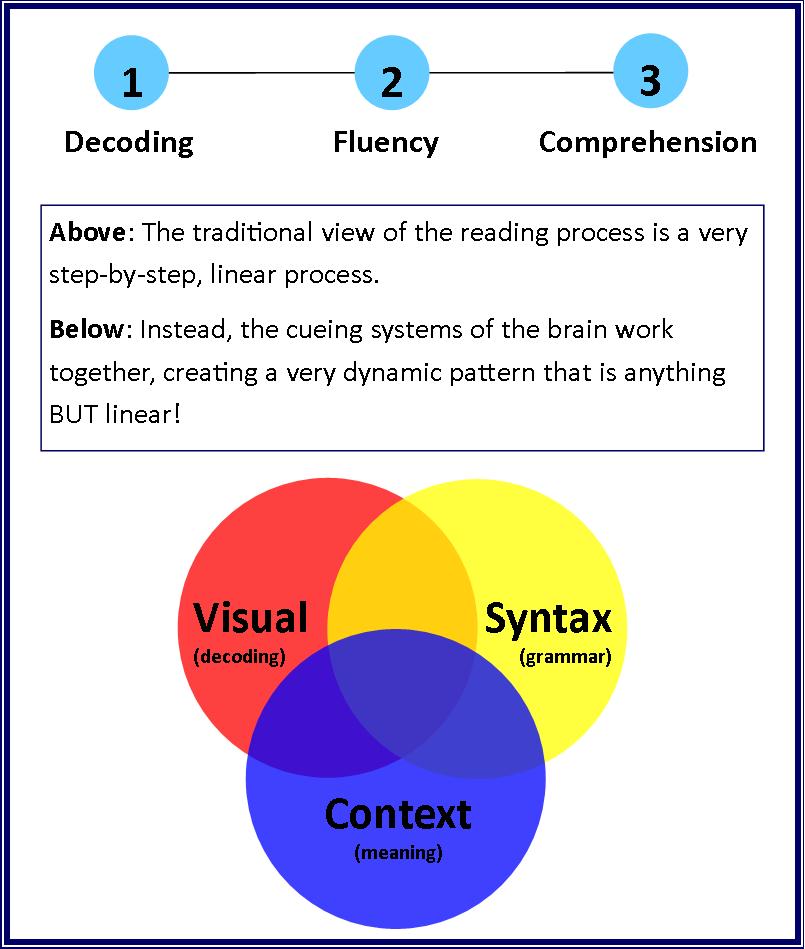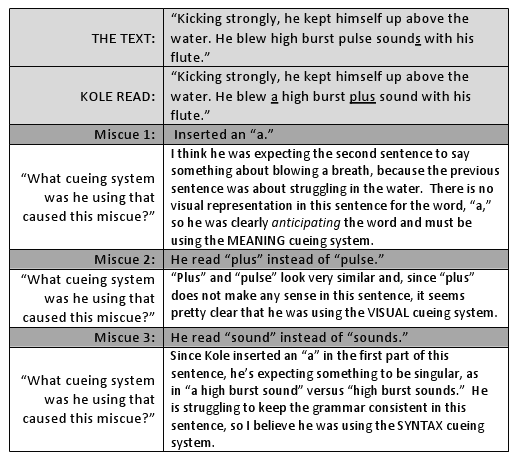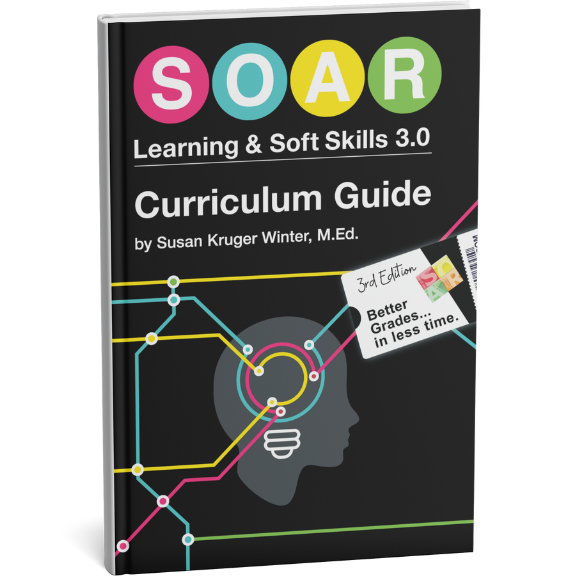“The Cue to Reading” Series (Article 3): When Mistakes are Golden
By now, you may be getting a little “tired” of all of this talk about cueing systems, but these first three articles are synthesizing what I believe to be the most significant information about the reading process. Out of the thousands of hours of training I have had between my master’s degree, several years of teaching, and years of additional training, I always seem to come back to the cueing systems.
Last week, I explained the linear assessments that my son’s reading teachers were using to determine his reading ability.

They were measuring only his reading fluency (verbal accuracy when reading aloud) and completely ignoring his comprehension skills. Fluency tests, also known as “running records” (which are very popular these days), only measure the accuracy of the visual cueing system. For my son, this is his weakest cueing system. He is very talented in the other two systems, but that was not discovered by his teachers because their assessment tools assume that reading is a linear process, beginning only with decoding/fluency, then ending neatly with comprehension.
There is an assessment that can be done that is much like a “running record,” but adds another layer of analysis. This additional layer digs deeper into the cueing systems and unlocks the mystery of what is happening in your struggling reader’s brain.
The Miscue Analysis
When I work with a struggling reader, I explain that their “mistakes” are really a sign of great things that their brain is doing in order to make sense of our crazy language! It usually takes a lot of time to convince them of this; they are not used to thinking of mistakes as being a good thing. For a “miscue analysis,” however, they are gold!
In fact, the World of Reading does not call them “mistakes” because that word is misleading. Instead, they are called “miscues” because that is what they are….one of the cueing systems not working properly. With some detective work, you can learn what cueing system(s) a student is using and how accurately they are doing so. You can also learn what cueing systems are deficient, so you can efficiently remediate the reading challenge.
How Does A Miscue Analysis Work?
To say that there is only one way to do a miscue analysis is like saying that there is only one recipe for baking bread. In truth, there are some basic ingredients, but many variables. The same can be said for a miscue analysis; there may be a few reading teachers who read my description and think “That’s not how I do it!” That’s okay. I’ll try to stick to the basic ingredients.
As the name suggests, this assessment is a process of documenting all miscues, then analyzing what cueing system the student is likely using that generated that miscue.
When administering a miscue analysis, the teacher will have two copies of the reading passage. The student will read one while the teacher takes notes on the other. The teacher records everything a student says that is not exactly as it was written in the text. In other words, the teacher records the miscues. At the conclusion of the reading, the teacher goes back and formally analyzes the miscues. The key question that will be asked during this analysis is “What cueing system was the student using to generate this miscue?”
For example, I gave a miscue analysis to Kole, a third-grade student. In this chart, I have analyzed three miscues he made within one sentence. It is a great example because it happens to include all three types of miscues:
You can see the thought process that goes into analyzing WHY each miscue was made. There is some subjectivity to this process, but after analyzing 25 or more miscues, you will see clear patterns emerge.
What Do You Do With This Information?
The ultimate goal of doing a miscue analysis is to determine what cueing systems a student is using and how well they are being used. 90% of the time, you will find your struggling students fall into the pattern of being a “visual reader.”
A visual reader relies primarily on visual cues, identifying words only by “sounding them out.” We call these students “word callers” because the read like they are calling off a list of words, not making sense of what they are reading. Since phonics skills are typically the first and easiest skills to teach, you will most often find students who are over-reliant on these skills.
The significant reason for doing a miscue analysis, however, is that visual readers do not “sound” like they know their phonetic skills. To the untrained ear, they will sound like they are severely struggling to sound out words, which lead many teachers and parents to think that the child needs more lessons in phonics. However, upon closer examination of their miscues, you will often find that they are overusing phonetic principles to guess at words.
Did I mention that the English language is crazy? There are so many “exceptions to the rules” for a phonetic reader. The only way to learn these exceptions is to develop a more mature sight vocabulary AND learn how to better develop their contextual and grammatical cueing systems. This is usually done through cloze exercises and teaching comprehension strategies.
The remaining 10% of your readers will exhibit a variety of patterns, typically utilizing a mixture of the three cueing systems. Some miscues will be made due to the visual cues from the letters, but these readers will exhibit a much greater number of “syntax” or “meaning” errors. They will start saying words that they predicted would be in the passage, which may not look anything like the word in the text. For example, the sentence might be written as, “They were going to go swimming in the ocean,” but the child read, “They were going to go swimming in the water.” The meaning of the second sentence was still intact, indicating that this child was using the “contextual” cueing system.
A Triangulated View
A good miscue analysis will analyze the student’s reading fluency, comprehension, and miscues to get a full picture of the student’s reading behaviors and abilities. This analysis is not scientific or entirely objective. In fact, there are more “objective” ways to administer a miscue analysis than others, but I typically find that a general observation of the cueing systems is sufficient to determine the best instructional methods and to determine if any further testing would be warranted.
In my son’s case, I knew strictly from informal observations that something was wrong. However, I gave him a slightly more formal assessment so that I could have data to share with his teachers and health professionals (i.e. 1st grade reading passage, 82% fluency, 100% comprehension). The miscue analysis verified that he was very strong in two cueing systems and extremely weak in the third. These patterns are flags for a learning disability. From there, I needed the input of trained professionals and standardized evaluations to give me a solid diagnosis.
This article is not intended to be an instruction manual on how to give a miscue analysis or score one. There are many other books, videos, and other resources available to cover that information. I found this quick overview on YouTube.com: http://www.youtube.com/watch?v=wL7zC6mbzEY. The presenter is slightly zany, but in an authentic way. The information, however, is solid.
In the following weeks, I will address specific methods for addressing reading concerns, finding additional help, and other factors that play a role in reading difficulties.
-Susan Kruger
EB 082117
Six Steps
Conquer the Chaos
Get Our Free Guide & Information on...
 How to Organize & Motivate Students for Success
How to Organize & Motivate Students for Success
"*" indicates required fields
Get Our FREE Curriculum Guide!
The SOAR® Curriculum
The most critical learning, organizing, and communication skills needed for school. Learn more here.
Who’s Using SOAR®?
SOAR® Guarantee
Click here to learn more.





